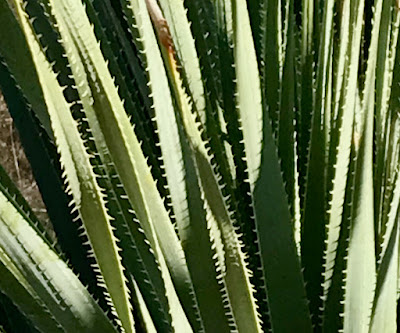This is my beloved Sonoran Desert where I hiked yesterday in bright sunshine and just-right temperatures in the 60s. I think it's the most beautiful place I've ever lived, but it does have a dark side. It's full of poisonous creatures and prickly plants that force you to be always alert.
Here are a few from my hike yesterday in Catalina State Park:
This venomous rattlesnake was coiled and camouflaged on the edge of one of the most popular hiking trails in the park, Canyon Loop. Luckily for me, another hiker warned me about it so I stepped cautiously and stayed on the other side of the path. (I zoomed in to the max for this photo.)
These wicked thorns are on the saguaro cactus, that tall one with arms in the first photo. You definitely don't want to lean up against it.
One of the main functions of cactus needles is to protect the plant from animals that may want to munch on it. The needles also provide some shade. While it may seem impossible for a single spine to provide shade, their collective contribution helps make it possible.
These long thorns (above) are on the prickly pear cactus, so named because the cactus pads are pear shaped and prickly. Most of these grow low to the ground, but I have one at the corner of my house that reaches the roof. Whoever planted mine thoughtfully chose a thornless variety.
This gnarly, lumpy plant is a cholla, and you don't want to fall into one. I saw a photo of a mountain biker who crashed into one and was covered from head to toe with pieces of cholla that had pierced his clothing. Clumps of this cactus break off easily and stick to their victims, which is why it's sometimes called "jumping cholla." Barbs make it difficult to remove it from your skin.
These slender leaves are a yucca, I think. Otherwise it's an agave, but usually agaves are thicker. The spines along the edges could saw through your skin pretty quickly. Stay away!
And this last pile of prickles from yesterday's hike is a closeup of a palo verde tree. Palo verde means "green stick," and the green allows the tree to carry on photosynthesis even without leaves.
For more info and photos of cacti, check out my blog from last summer: cactusland.html
The picture below isn't my desert, but the Grand Canyon in northern Arizona. It was posted by the park service on Facebook for Halloween!
Have a colorful day








Wow! Love your hiking pictures. And the last one is a hoot!
ReplyDeleteGreat post, Sherrie! Good thing you got the heads up on the snake... better to give it a very wide berth... the scenery is awesome, glad you are able to get back out and enjoy it again.
ReplyDelete